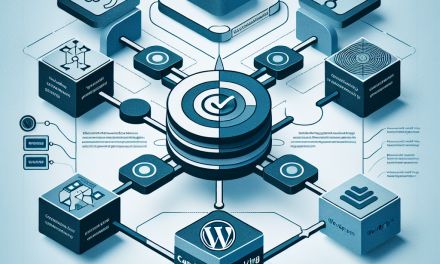Managing a large content archive in WordPress can be a daunting task, especially as your website grows and diversifies. However, with the right strategies in place, you can enhance user experience, improve navigation, and ensure your content is easily discoverable. Here are some effective strategies for organizing large content archives in WordPress.
1. Utilize Categories and Tags Wisely
Categories and tags are essential for sorting your content. Use categories to define broad topics and tags for more specific keywords related to your posts.
- Create a Hierarchical Structure: Organize your categories in a parent-child format for better clarity.
- Limit the Number of Tags: Avoid over-tagging as it can lead to confusion; keep it relevant and focused.
For more on how to manage categories and tags, check the official WordPress documentation.
2. Implement a Search Functionality
A robust search feature allows users to find content quickly. Consider implementing popular search plugins like SearchWP or Relevanssi to enhance the default search functionality.
3. Create an Archive Page
Set up a dedicated archive page that lists all your posts, either in chronological order or by category. This provides a comprehensive overview and helps users find what they’re looking for.
- Use Shortcodes or Plugins: You can leverage plugins like Simple Yearly Archive to create an organized layout with ease.
4. Implement Custom Post Types
If your content varies in type, consider creating custom post types. For instance, if you have tutorials, reviews, and news articles, keeping them separate can streamline user navigation.
- Follow the Guide on Custom Post Types: For a comprehensive guide on creating custom post types, visit the WordPress Developer Resources.
5. Categorize Content with a Tag Cloud or List
Displaying a tag cloud or a list of categories in your sidebar allows users to explore content quickly.
- Configuring Widgets: You can easily add a tag cloud via the native WordPress widgets. Learn more about widgets in the WordPress Codex.
6. Optimizing Navigation with Menus
Utilizing menus is an effective way to organize content. Create custom menus that prioritize the most important sections of your archive.
- Hierarchical Menus: Build nested menus to help users understand the relationships between different content types.
Visit the WordPress Custom Menus Documentation for more details on menu creation.
7. Leverage Page Builders
Utilizing page builders like Elementor or Beaver Builder can help visually organize content archives in an appealing and user-friendly manner.
- Custom Layouts: These tools allow for flexible design options to showcase your archives creatively.
8. Include Related Posts
Incorporating related posts at the end of your articles can keep users engaged and help them discover more content smoothly.
- Using Plugins: Plugins like Yoast SEO and Contextual Related Posts can automatically display related content.
9. Regularly Update and Maintain Your Content
Regularly audit your content to remove outdated posts, update links, and refresh information. This ensures that your archive remains relevant and useful to your audience.
10. Consider Utilizing a Digital Asset Management Plugin
For extensive media files or documents, a digital asset management plugin such as WP Media Folder can significantly enhance organization and retrieval.
Conclusion
Organizing a large content archive in WordPress doesn’t have to be overwhelming. By implementing these strategies, you can create a seamless navigational experience for your users, ensuring they find the information they need easily and efficiently.
Are you ready to take your WordPress site to the next level? Explore WafaTech NextGen WordPress Hosting for optimized performance and tailored solutions. For more details, visit WafaTech WordPress Hosting today!
By following these techniques and utilizing the right tools and plugins, you can effectively manage your substantial content archives, creating a more user-friendly experience for your audience. Happy blogging!





